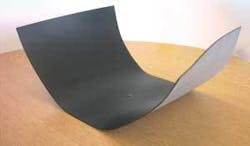Laser forming looks in good shape
As a method of automated distortion correction, laser forming requires no mechanical contact and has no “spring back” effect
G. Dearden, S.P. Edwardson, E. Abed, and K.G.Watkins
The correction of distortion and design shape in manufactured non-ferrous components is increasingly in demand in industry, particularly as applications for aluminum and its alloys continue to expand. The need for such correction arises because of factors such as the accumulation of various process tolerances during production, unwanted distortion of the part shape that occur during or after processing (such as welding) with unpredictable and often irreversible effect, or deviation from design shape resulting from damage during operational service or storage (which may require remedial correction if its usefulness and value are to be maintained). Within this context, a process capable of achieving these actions in an automated, controlled, and precise manner would be of significant benefit to industry.
Remedial measures for distortion studied so far involve either increasing the rigidity of the structure during the stress-inducing process, through improved design and special clamping, or reducing the stresses through process modifications. However, there is currently no automated or controllable method for correction of the distortion either during or after processing of the structure. Although several techniques of stress reduction have been studied (including cold compression or stretching, thermal treatments, and advanced ageing treatments), none have so far achieved full stress removal and all are limited in their flexibility of application. A study has been conducted by the Laser Group at the University of Liverpool on the use of laser forming (LF) as a method of automated distortion correction.
The LF process has been shown to be potentially viable for 2D bending and 3D shaping of metallic and non-metallic components for applications such as rapid prototyping (in aerospace, automotive, and shipbuilding sectors) and precise alignment of micro-components (in microelectronics sector). In contrast to conventional forming techniques, LF requires no mechanical contact, does not suffer from the ‘spring back’ effect of mechanical forming, and offers many process flexibility and automation advantages associated with other laser processes.
LF generally employs a loosely focused laser beam to induce thermal stresses into the surface of a workpiece. These internal stresses induce plastic strains, which bend or shorten the material, or result in a local elastic-plastic buckling of the workpiece, depending on the active LF mechanism. 2D LF (out-of-plane bending) can also achieve 3D forming results such as a fold along an arc path, while 3D LF uses combinations of multi-axis 2D out-of-plane bends and in-plane localized shortening to produce 3D spatially formed parts; for example a dome. 2D LF can control bend angle with reasonably accurate results in a range of materials including aluminum, but less work has been completed for 3D LF.
To apply LF to the correction of distortion and design shape, further research into the control of the 3D LF process was required to establish potential routes towards a reliable, repeatable, and reasonably cost-effective means of distortion correction in a manufacturing environment. A key requirement for the control of the 3D LF process is to develop a predictive model that can generate appropriate laser irradiation scan strategies to either fully form or partly form the part into the required geometry, with the rate and distribution of forming across a surface being controlled by process parameters such as scan speed. To this end a system for the controlled 3D LF of continuous surfaces was further developed as part of this study.
Investigations into the use of purely geometrical data from a component as a basis for scan strategy development identified an error between a measured surface and the desired surface that yielded sufficient information for the scan strategy or scan path of the laser to be derived. The magnitude of the error provided a means of varying the process speed and hence the magnitude of forming in a given zone. Employing an iterative pass-by-pass approach allowed the development of a feedback control system (see Figure 1). This iterative error-based method was shown to be a significant step towards controlled 3D LF and, as this method relies on the error between a component and a design shape, it was considered to be ideal for the correction of unwanted distortion.
null
null
FIGURE 1. Iterative-error-based closed-loop 3D LF of an aerospace style component from flat sheet. a) Target shape b) Predicted scan path for given iteration (speed represented by dot size) and c) Laser formed part.
Following on from earlier work, the method of scan strategy prediction involved defining the desired surface shape as a Bezier-bicubic surface patch (a mathematical function to define a continuous 3D surface from a limited number of supplied coordinates) and analyzing surface properties such as gradient and curvature. The degree of forming required for each irradiation scan line was deduced from the magnitude of the gradient vector along each line. The laser parameters required were then determined from calibration curves produced in 2D LF experiments, using the equivalent conditions for the initial pass. The most practical method of controlling the energy input to a scan line was to vary the laser scan velocity for a given laser power/spot size. This procedure was incorporated into a routine written in MATLAB.
A key understanding of the LF process limitations for shaping 3D components was also developed as part of this study1, where a distinction was made between what is known in mathematical geometry terms as ‘developable’ and ‘non-developable’ surfaces. A developable surface is defined as a surface that can be unfolded into a single plane surface without stretching or tearing, while a non-developable surface would require material thickening or removal to achieve the same result. Therefore forming of developable shapes is more associated with TGM (Temperature Gradient Mechanism) based LF for out-of-plane bending, such as a part cylinder, while a non-developable surface, like a dome or pillow, would need much more in-plane shortening, using the upsetting mechanism to some extent.
Through analysis of the sign and magnitude of the Gaussian curvature of a surface (as there is a limit to the degree of shortening available with LF), it was possible to determine whether a component could realistically be laser formed. A middle ground between the two surface types was also discovered, in that areas of low non-developability (defined by the magnitude of the Gaussian curvature) can be laser formed in a wholly formable developable surface; the aerospace style component in Figure 1 being an example. A subtle distinction was realized; although a component may well be non-developable and therefore difficult to laser form from say flat sheet, it is the error between the as-received component and the design shape that determines whether it can be laser formed, in that a complex component may only require a small correction using TGM conditions to restore dimensional accuracy.
In addressing the development of a LF system for automated correction of distortion and design shape, an extension of earlier LF work was undertaken in which an iterative methodology was derived to develop the final required shape through a series of steps. This also allowed the presence of pre-existing residual stress in the parts to be taken into account, which was a problem with the LF process prior to this work. The internal stresses due to the previous processing history of the component material could not be guaranteed or closely predicted, and it can be expected that much of the sheet material to be used will contain pre-existing residual stresses that influence the errors in a planned LF operation. In the iterative procedure developed, an initial LF run partly formed the component, with the initial scan path and the point-by-point laser parameters required being determined by the MATLAB procedure. The results of the preliminary laser scan were then compared with the predicted results and a recalibration of the LF system wascarried out based on the errors between the two. A second laser scan strategy was then computed, based on this knowledge of the difference between the predicted and achieved shape changes. This was repeated in further iterations until the final required shape was reached. As the end point was approached, the laser scan speed was increased to progressively reduce the degree of forming.
A strut component of 400 x 40 x 2mm AA5251 material was selected as being a generic part similar to chemically etched distorted components witnessed on the shop floor of aerospace partner companies visited during the investigation. A series of random non-uniform distortions were mechanically formed, by roller, on the struts and LF applied to try and re-flatten them in a controlled manner. Using the iterative, corrective control method based on geometrical error and data calibration from previous tasks, it was possible to remove the distortion in these components and return them to the design shape (that is, flat) to within a few mm of error (see Figure 2).
The demonstrator system thus shows great promise for the application of LF to the correction of distortion. We are now seeking partners in industry to take this work forward as further investigation is required to ascertain limits to the complexity of distortion that can be reversed using the technique, to reduce surface measurement time, perhaps with white light fringe projection techniques, and to allow the LF of more complex structures (by adding CNC axes).
This work was carried out with the support of EPSRC (grant number: GR/S43276/01).
References
1. Edwardson SP., Abed E., French P., Dearden G., Watkins K.G., McBride R., Hand D.P., Jones J.D.C., and Moore A.J. (2005) “Developments towards controlled three-dimensional laser forming of continuous surfaces.” Journal of Laser Applications vol 17 issue 4 pp 247-255.
G. Dearden, S.P. Edwardson, E. Abed, and K.G.Watkins are with the Laser Group, Department of Engineering, University of Liverpool (UK). Stuart Edwardson can be contacted at [email protected].




